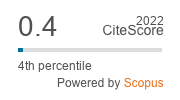Population ecology and ETs based time series for climate smart pest management of Spilosoma obliqua Walker
DOI:
https://doi.org/10.33307/entomon.v45i1.500Abstract
The two-sex pooled life table of S. obliqua Walker (Lepidoptera: Arctiidae) was constructed along with their population density and yield loss estimation to determine their economic thresholds (ETs) based time series on two different crops such as sesame (S. indicum; cv. Rama) and green gram (V. radiata; cv. KB-54) in 2019. The population ecology and ETs of S. obliqua were significantly (P<0.05) affected by the host phytoconstituents in terms of host suitability or susceptibility (sesame>green gram). Average EIL and ET for S obliqua was 26.388±1.627 and 24.230±2.412 pests/30 plants, respectively for sesame that were insignificantly (F1,4=2.794-3.335; P≥0.142) differed from the green gram. For a single pest per m2 (30±2 plants/m2) the possible time that can be taken to reach EIL (Ti) and ET (Tt) were 38.246±1.157 and 37.246±1.157 days, respectively on sesame which were significantly (F1,4=24.111; P=0.008) lower than green gram. Even, ETs based time series was also calculated to find the specific time (Tt days) to reach ET for any number of pest(s) on the selected crops for time based management. The benefit cost ratio (BCR/ha) of sesame and green gram was 0.478 and 0.390, respectively with significant (P<0.05) deviation. The carbon sequestration efficiency (CSE) of sesame (301.860 kg/ha) was significantly (P<0.05) higher than green gram (172.260 kg/ha) due to more biomass production. These findings will obviously help farmers to choose sesame as a suitable trap crop for green gram on the basis of pest attraction or susceptibility, ETs based time series, BCR values (sesame>green gram) as well as CSE for climate smart pest management (CSPM) by applying appropriate control measures judiciously if required within the time limit to reach the ETs as in time series for sustainable climate smart agriculture (CSA) of such crops in near future.


